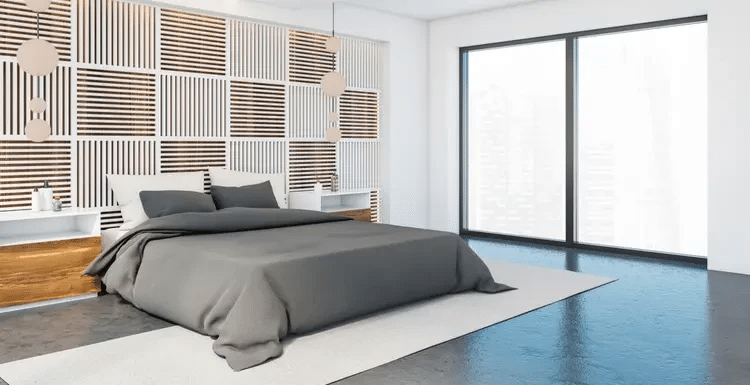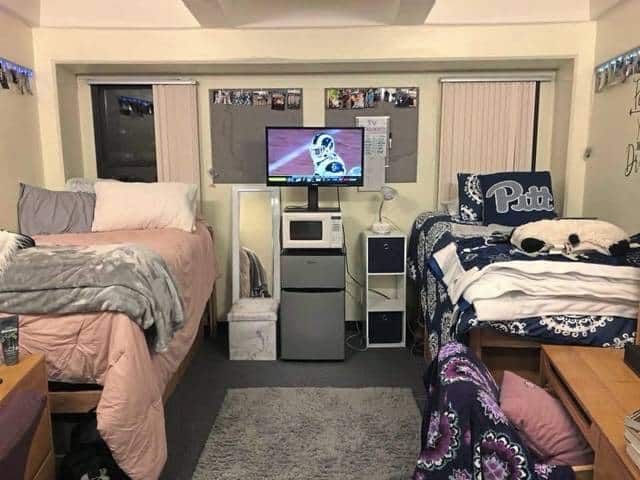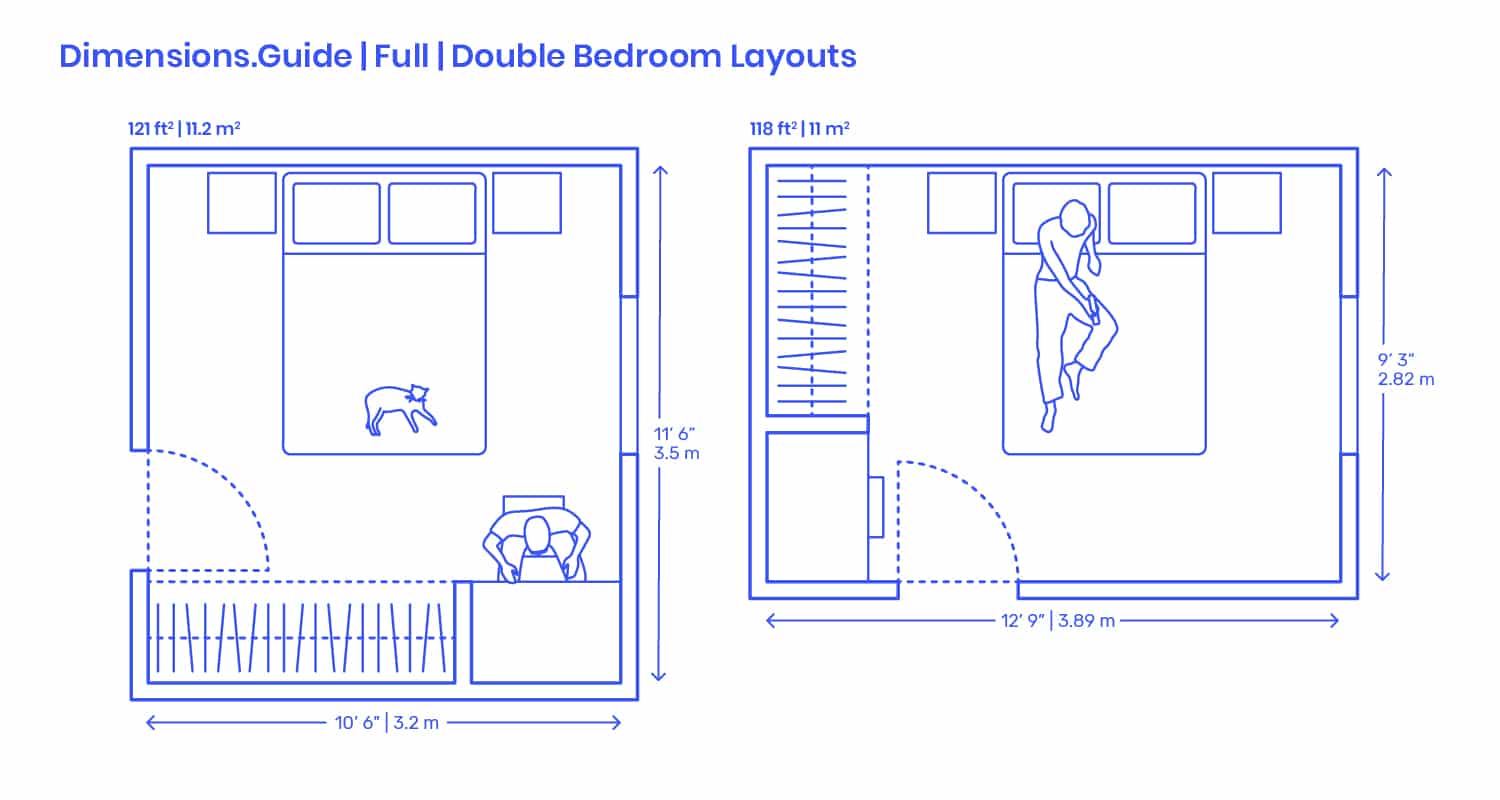Design Consideration for Average Size Bedroom

Let’s check out the secrets to designing the perfect bedroom that suits your style and comfort. Think of going into a room that feels just right, like a comfy cover to your needs. Start creating your ideal average-size bedroom with an understanding of the Typical bedroom size and how it can influence your design choices.
The size of your bedroom sets the stage for everything from the arrangement of furniture to the overall view. If you dream of cool places for relaxation or an energetic spot for creativity, the size of your bedroom plays a key role. So here we’ll help you to find the average size bedroom and design considerations.
We’ll help you navigate through the process of arranging furniture, selecting colors, and making the most of your space. A well-designed and average size bedroom can light up your life every day.
So Let’s go to create your bedroom into a personal space that reflects your style and increases your well-being.
1. Primary Bedroom Size

The primary bedroom is an average size bedroom, often a space within a home, and generally spans about 200 to 300 square feet. This expansive chamber gives a cool sleeping area alongside the room for various furnishings such as bedding sets, dressers, nightstands, and perhaps a welcoming seating spot.
The arrangement of the Standard bedroom dimensions frequently involves crafting a soothing atmosphere using well-considered lighting, a thoughtfully selected color palette, and engaging textures.
The addition of windows might serve to welcome daylight while upholding a pinch of privacy to your typical bedroom size. This room stands as a good place, offering rest and energy, with its range catering to relaxation and a quiet balance between form and function.
2. Standard Bedroom Size

A standard bedroom size generally varies between 120 to 150 square feet, providing enough room for important furnishings like a bed, textured rug, dresser, and nightstand.
The creation of a normal bedroom space revolves around improving the given area, combining smart storage options, and choosing fitting furniture that maintains a balanced view within the space. The challenge lies in crafting a layout that ensures comfort and practicality without overcrowding the room.
This typical bedroom size involves thoughtful placement of each element to achieve a gentle arrangement. Also, attention to detail plays a pivotal role in achieving an aesthetically pleasing yet usable setup.
By carefully selecting colors, textures, and patterns, a characterized and pleasing environment can be established in your average-sized bedroom. The objective is to organize a standard bedroom that shows a hint of peace and well-being, promoting relaxation and peaceful rest.
3. Average Dorm Room Size

In schools, the average size of the bedroom where students stay is often quite small, about 100 to 150 square feet. They’re designed to work well even though they’re not very big. The beds are raised to make space for storage underneath, and there’s a small fridge for snacks and drinks.
The furniture can be changed around to make the room useful for different things. People can pick colors and decorations they like in their average-sized bedroom, so the room is good for studying and relaxing.
Even though the rooms are small, they’re made to be comfortable and fit different needs. The way things are laid out, the colors used, the decorations, and the little fridge all make the Normal bedroom space good for both work and fun, which is important for students who have busy lives.
4. Average Kid’s Bedroom Size

Kids’ bedrooms, usually between 80 to 150 square feet in size, need careful planning to make the most of normal bedroom space. Making a fun and useful space involves using lively colors, creative designs, a desk and chair for kids, and good storage for toys and things they own. Making sure it’s safe is very important, with rounded edges and strong furniture to keep curious kids safe.
This process is about being creative and practical in an average-sized bedroom, where everything has a job but still feels magical. These spaces help kids explore and grow, making them a special place for sleep, learning, and play.
Putting furniture like kid’s beds and decorations together in a good way makes a mix of productivity and glamour for the special needs of young people.
5. Master Bedroom Size

Standard bedroom dimensions play a significant role in designing a comfortable sleeping area. The average master bedroom size, usually ranging from 200 to 300 square feet, feels really big. You can set up a comfy space here with bedside tables, a large bed, and extra furniture.
The average master bedroom size is so spacious that you can move around freely and have a peaceful area to relax. Also, it’s great to have closets and bathrooms connected to the room for convenience and luxury.
By picking the right colors and lighting, you can make the average size bedroom feel even more peaceful. This bedroom is like a blank canvas where design and practicality come together to make a relaxing and kind space.
6. Standard Bedroom Size with a Queen Bed

A typical bedroom featuring a queen-sized bed generally covers an area of 150 to 200 square feet, providing enough room for the bed itself, nightstands, and even some space for work. Ensuring appropriate gaps between furniture elements, such as nightstands, is essential to facilitate smooth mobility and to prevent the room from feeling overly congested.
The strategic arrangement of furnishings, including nightstands, contributes to a well-proportioned design that guarantees comfort and practicality in your average size bedroom.
Employing soft, muted tones and innovative storage ideas can make your area more interesting, resulting in an increasing sense of airiness within the room. By careful arrangement of items, such as nightstands, the bedroom can flow a balance and utility.
7. Small Bedroom Dimensions

Compact average-sized bedroom typically lasts 80 to 120 square feet and demand careful planning to maximize utility. Favoring a single twin or twin XL bed along with Wall-Mounted Shelving Units is a practical choice, allowing room for efficient additions like wall-mounted shelving units and discreet under-bed compartments.
Mirrors play a strategic role in creating an illusion of spaciousness in your average size bedroom, while cleaning up the spot becomes important. Smart organizational strategies coupled with flexible furniture solutions and wall-mounted shelving units become necessary, enabling these modest chambers to shine truly.
8. Standard Bedroom Size for a Guest Room

Common bedroom measurements for a guest bedroom typically help a full or queen-sized bed, lasting between 120 to 150 square feet, making a balance between comfort and space efficiency.
The decor shows a hint of glamour, with decorative pillow covers offering a comfy spot for guests. Thoughtfully placed essentials such as a nightstand and a reading lamp increase the room’s practicality, providing convenience during their stay.
Involve enough storage options for visitors’ belongings, while carefully chosen linens add a hint of style to their experience. The room’s look, including soothing tones and endless design elements, adapts smoothly to diverse guest preferences.
This personal space captures the essence of understated fashion, making it a spot that welcomes guests in friendliness and comfort. It’s an inviting average-sized bedroom that easily combines simplicity and attraction, ensuring a memorable and delightful stay for anyone who enters.
Design Considerations

When you’re thinking about how to design Common bedroom measurements, there are a lot of things to make it feel comfortable. Just a picture mixing bright blue and gray colors.
This mix makes the room look modern and stylish. Another choice is to use navy, white, and yellow colors. Navy makes things feel peaceful, white makes everything seem pure, and yellow adds a lively view.
So grab these ideas and make your average-sized bedroom a kind and lovely spot.
1. Bright Blue + Gray
Vivid blue and soft gray colors go together really well in Standard bedroom dimensions, making them great for decorating your bedroom with items like Blue Cushion Covers. The lively blue adds an energetic vibe, while the gray brings a hint of kindness.
When these colors come together, they create a balanced mix of fashion and peacefulness in the average-sized bedroom, making it a perfect place to relax with the added comfort of Blue Cushion Covers.
You can use blue for small things like cushions and decorations, while gray works best for walls and bigger furniture. This combination gives the room a refreshing balance, creating a space that’s perfect for relaxing.
2. Navy + White + Yellow
The mix of dark blue, bright white, and sunny yellow makes the average-sized bedroom design feel lasting and well-balanced.
The dark blue walls create a peaceful mood, while the addition of yellow throw pillows, along with the white trim and furniture, make the room feel open and light. Adding a pinch of yellow with things like these colorful pillows or nice artwork brings happiness and energy.
All these colors together keep the room welcoming, no matter what’s popular at the moment.
The way these colors come together with the yellow throw pillows makes the room feel comforting and stylish, like a safe and happy place that never goes out of style.
3. Pink + White + Wood
Mixing shades of graceful pink, pristine white, and the earthy affection of wood, a bedroom view comes to life, characterized by its inviting aura and tasteful aesthetics.
The walls are beautifully painted in shades of pink, giving off a pure and lovely look. They go perfectly with the white linens, furniture, and gentle, warm glow of Pink and White Lamps.
It’s an attractive composition that shows feelings of restfulness and style, making it an irresistible haven for relaxation in your average size bedroom.
4. Cool Gray
Soft shades of gray create a kind feeling in your bedroom, like a peaceful spot. Gray-scented candles with a gentle flicker add beauty. They make the room feel soothing and quiet, which is great for relaxing after a long day.
There are different kinds of gray, some light and some deeper, that give off different vibes. Light grays can make the room feel open and breezy, while darker grays make it feel restful and pleasant.
You can use lots of different shades of gray, including those in the Gray Scented Candles to your average size bedroom, to make a vibe that matches your personality.
Gray colors can be used on walls, bedding, decorations, and with the soft light from scented candles. This makes a space that feels peaceful. This color invites you to relax without any distractions.
It’s like a canvas that you can add your style to, with the Gray Scented Candles making the room smell nice and creating a comfortable and relaxing place.
Conclusion
Now you have all the knowledge you need to plan your ideal size bedroom and design. Designing a bedroom might seem a bit complex at first, but with these basic considerations in mind, anyone can do it.
The size of your bedroom matters because it affects your comfort and the furniture you can place.
Think about how you’ll use the space and what furniture will fit comfortably.
The design choices you make, like colors, lighting, and furniture arrangements, can impact the space and mood of the room.
Remember, average size bedrooms come in different sizes and styles, so you can choose what suits your needs best.
And designing a bedroom with your ideas can be an enjoyable process. Once your bedroom is set up, it can provide a peaceful spot and a comfortable space for you to relax.
Creating your perfect bedroom can be a fulfilling experience. So, give it a try and grab the art of bedroom design.






